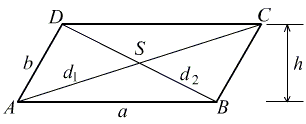Every Parallelogram Is a Rectangle
Given parallelogram ABCD we denote two of its opposite sides a and the other b. The diagonals are d1 and d2.

Let denote H(p, q, r) Heron's formula for a triangle with sides p, q, r.
Consider triangles ABC and DAB; there sides are a, b, d1 and a, b, d2, respectively. The equality of the areas could be expressed in terms of Heron's formula:
H(a, b, d1) = H(a, b, d2),
from which we conclude that d1 = d2. However, a parallelogram with equal diagonals is necessarily a rectangle.
This conundrum is due to Vladimir Nikolin, an elementary school teacher from Serbia.
Related material
| |
Geometric Fallacies | |
|
| |
|
| |
|
| |
|
| |
|
| |
|
| |
|Contact| |Front page| |Contents| |Geometry| |Proofs|
Copyright © 1996-2018 Alexander Bogomolny73502628
